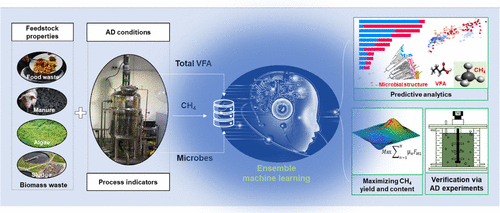当前位置:
X-MOL 学术
›
ACS ES&T Eng.
›
论文详情
Our official English website, www.x-mol.net, welcomes your feedback! (Note: you will need to create a separate account there.)
Data-Driven Based In-Depth Interpretation and Inverse Design of Anaerobic Digestion for CH4-Rich Biogas Production
ACS ES&T Engineering Pub Date : 2022-01-21 , DOI: 10.1021/acsestengg.1c00316 Jie Li 1 , Le Zhang 2, 3 , Chunxing Li 4 , Hailin Tian 2, 3 , Jing Ning 5 , Jingxin Zhang 3, 6 , Yen Wah Tong 1, 2, 3 , Xiaonan Wang 7
ACS ES&T Engineering Pub Date : 2022-01-21 , DOI: 10.1021/acsestengg.1c00316 Jie Li 1 , Le Zhang 2, 3 , Chunxing Li 4 , Hailin Tian 2, 3 , Jing Ning 5 , Jingxin Zhang 3, 6 , Yen Wah Tong 1, 2, 3 , Xiaonan Wang 7
Affiliation

|
Anaerobic digestion (AD) is one of the most widely used bioconversion technologies for renewable energy production from wet biowaste. However, such an AD system is so complicated that it is challenging to fully comprehend this process and design the operational conditions for a specific biowaste to achieve CH4-rich biogas. In this context, ensemble machine learning (ML) algorithms were employed to develop multitask models for jointly predicting the CH4 yield and content in biogas and understanding this complicated process. Based on the best ensemble model with the R2 values of 0.82 and 0.86 for the multitask prediction of CH4 yield and content, the top three critical factors for CH4 yield/contents were identified and their interactions with process acid generation and microbial community in the AD process were comprehensively interpreted to unveil their importance on CH4 generation. Moreover, the well-developed ensemble model was integrated with an optimization algorithm to inversely design the AD process for a real-world food waste, in which the CH4 yield was as high as 468.7 mL/gVS and the calculation results were experimentally validated with relative errors of 9–16%. This work provides a creative approach to gain insights and inverse design for AD reactors, which is helpful to waste-to-energy technologists and practitioners.
中文翻译:

基于数据驱动的富甲烷沼气生产厌氧消化的深度解释和逆向设计
厌氧消化(AD)是最广泛使用的生物转化技术之一,用于从湿生物废物生产可再生能源。然而,这样的 AD 系统非常复杂,因此很难完全理解这一过程并设计特定生物废物的操作条件以实现富含 CH 4的沼气。在此背景下,集成机器学习 (ML) 算法被用于开发多任务模型,用于联合预测沼气中的 CH 4产量和含量,并了解这一复杂过程。基于R 2值为 0.82 和 0.86 的最佳集成模型对 CH 4产量和含量的多任务预测,CH 4的前三个关键因素确定了产量/含量,并全面解释了它们与 AD 过程中酸生成和微生物群落的相互作用,以揭示它们对 CH 4生成的重要性。此外,将完善的集成模型与优化算法相结合,对实际食物垃圾的 AD 过程进行逆向设计,其中 CH 4产量高达 468.7 mL/gVS,计算结果通过实验验证9-16% 的相对误差。这项工作提供了一种创造性的方法来获得 AD 反应器的洞察力和逆向设计,这对废物能源技术专家和从业者很有帮助。
更新日期:2022-01-21
中文翻译:

基于数据驱动的富甲烷沼气生产厌氧消化的深度解释和逆向设计
厌氧消化(AD)是最广泛使用的生物转化技术之一,用于从湿生物废物生产可再生能源。然而,这样的 AD 系统非常复杂,因此很难完全理解这一过程并设计特定生物废物的操作条件以实现富含 CH 4的沼气。在此背景下,集成机器学习 (ML) 算法被用于开发多任务模型,用于联合预测沼气中的 CH 4产量和含量,并了解这一复杂过程。基于R 2值为 0.82 和 0.86 的最佳集成模型对 CH 4产量和含量的多任务预测,CH 4的前三个关键因素确定了产量/含量,并全面解释了它们与 AD 过程中酸生成和微生物群落的相互作用,以揭示它们对 CH 4生成的重要性。此外,将完善的集成模型与优化算法相结合,对实际食物垃圾的 AD 过程进行逆向设计,其中 CH 4产量高达 468.7 mL/gVS,计算结果通过实验验证9-16% 的相对误差。这项工作提供了一种创造性的方法来获得 AD 反应器的洞察力和逆向设计,这对废物能源技术专家和从业者很有帮助。


























 京公网安备 11010802027423号
京公网安备 11010802027423号